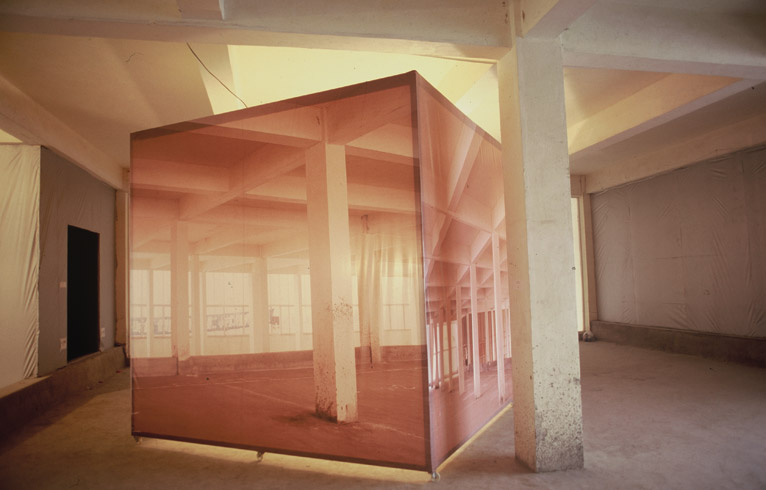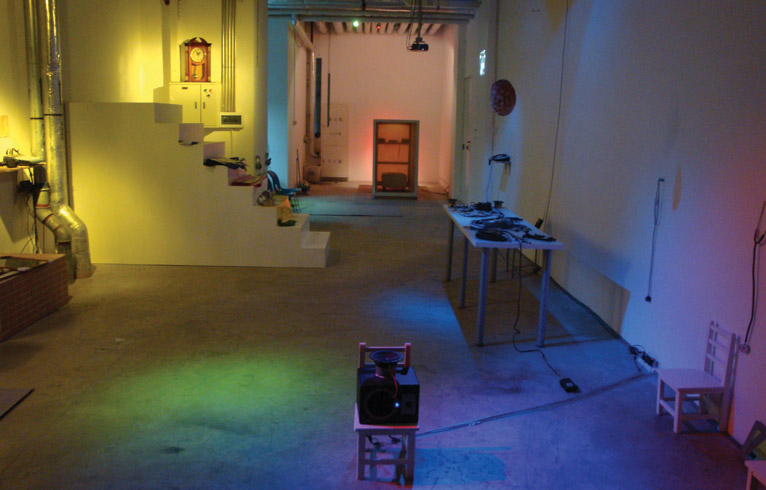A BRIEF HISTORY OF SPACE
| December 1, 2010 | Post In LEAP 6

In the 1980s, of course, no one talked about art spaces. Sure, artists intervened in the public realm, looking to bend it to their purposes. And of course there were always institutions, and the logic of coopting them for newer, bolder purposes was a motivation that then, as now, loomed large. (Look no further than the “China/Avant-Garde” exhibition, a fractious, self-satisfied attempt to win control, however temporary, of the National Art Museum.) But the idea of creating organic spaces to show work outside a gallery or museum context, which is mostly what we mean when we talk about “alternative spaces,” was not yet on the table. Until somewhere in the mid-1990s, the really interesting things went on behind closed doors, a phenomenon we now romanticize as “apartment art.” As Ai Weiwei put it, “the only places doing exhibitions were hotel corridors and framing shops.”
Critic Beatrice Leanza writes, “The trope of Apartment Art recurs in Chinese avant-garde history as a symbol of withdrawal that…represents a form of spatial detachment to which art recurrently subscribes as a way to disengage official modes of discourse and aesthetic languages by forging its own ‘domesticity’ and therefore space of existence.” In other words, the question of space was best ignored, as the possibility of creating anything approaching a viable, sustainable site was deemed too remote to even consider. Of course there are exceptions. We know that Xu Bing, back temporarily after his move to New York, staged his copulating pigs performance “Cultural Animals” at Beijing’s Hanmo Art Center; but we are hard pressed to say what this space actually entailed, or name anything else it did.
A comparative discourse of “art spaces” doesn’t really begin until the end of the 1990s, an era when there were basically three functioning galleries in China (CourtYard, Red Gate, ShanghART) and state-system museums did not show experimental work. The Hans van Dijk/Ai Weiwei space China Art Archives and Warehouse was perhaps the first institutionalized “alternative” to emerge from an atmosphere of daring curatorial practice, basement exhibitions, and frequent, unannounced closures. Wu Hung’s research from the year 1998-1999 offers the best eyewitness summary of this period. Confounded by the array of spatial possibilities, he set out, like a good positivist, to taxonomize them. In his book Exhibiting Experimental Art in China, published alongside “Canceled,” an exhibition in Chicago that told the story of how the Leng Lin-curated exhibition “It’s Me” was planned and closed, Wu assembles documentary dossiers on twelve exhibitions of the period, which unfolded in spaces ranging from the city’s then-trendiest night club (“Food as Art,” Club Vogue, 2000) to peasant dwellings just a few kilometers east of Sanlitun (“Trace of Existence,” 1998). In his characteristic way, Wu captured the last gasps of the truly pre-commercial epoch.

The early 2000s offered a first, fleeting glimpse of prosperity. By 2001, real-estate developers had caught on to art’s branding potential, and a brief flowering of spaces that might be labeled “alternative,” mostly because they were never clear on their own reason or duration, unfurled. The first SOHO development in Beijing included a collection of public sculptures curated by Ai Weiwei; places like the “Ocean Art Center” and “X-Ray Art Center” opened beside the model rooms being used to sell apartments in then peripheral, now central locations. Some interesting exhibitions were mounted—Zhang Li’s “Run Jump Crawl Walk” (April, 2002) at Ocean comes to mind—but the notion that developers were unreliable allies quickly gained currency among artists as these spaces succumbed to entirely predictable commercial and operational pressures.
There was a sense in the air of a coming revolution, one perhaps best captured by a project that drew very self-consciously on revolutionary language, the Long March. When Lu Jie and Qiu Zhijie wanted to convene an audience of like-minded aesthete-activists to explain their plan to retrace Mao’s historical journey with 250 artists, they could only do so in The Loft, a bar and restaurant owned by artist couple Wang Gongxin and Lin Tianmiao. Although not a proper exhibition facility, the backroom at The Loft was, for a few years, among the most active art spaces in Beijing, not unlike the tiny office on Huaihai Road then inhabited by the BizArt team in Shanghai. The Long March’s mandate, dreamed up by Lu Jie after a few years as a runner for Hong Kong dealer Manfred Schoeni and another few as a high-minded Goldsmiths graduate student, was to rethink the polemic of art’s space in society for a new century, and to adapt contemporary art, as Mao did Marxism, to the wisdom of the Chinese peasantry. It was a project ultimately better suited to a sustained offensive than lightning war, hence the decision, halfway through the journey, to return to Beijing and regroup the operation into an alternative space first called the “25000 Li Cultural Transmission Center,” after the fabled length (in Chinese miles) of the Red Army trek, and later renamed Long March Space.
By the fall of 2002, the first inklings of gallery districts had emerged in Beijing and Shanghai, and the idea of an art space outside the gallery system came to seem like a viable option. Despite lack of legal status, art organizations claiming non-profitability proliferated, starting with Vitamin Creative Space in Guangzhou. Founded by Zhang Wei, former assistant to Hans van Dijk, Vitamin opened the same week as the First Guangzhou Triennial in November 2002 in a rented room above a vegetable market. Despite its humble beginnings, Vitamin went on to ride its earnest likeability to the highest echelons of the international art world. Its position, like that of the contemporaneous Long March, is based on a smart strategy of calculated defiance to the Western system paired with (perhaps feigned) fealty to that system’s hierarchies and operational modalities.
The embryonic era between 2002 and 2005 now seems like ancient history, as BizArt founder Davide Quadrio suggests. This period saw a wide range of experiments as spaces came into use for periods of explicitly temporary duration. The classic example here is the current home of the Ullens Center for Contemporary Art (UCCA), which, poetically, was the furnace room that kept 798 running during its industrial days. The jewel of the former factory compound, the space first played host to exhibitions like Rong Rong and Inri’s Tui-Transfiguration (2003) and the Feng Boyi-curated Convergences (2005) before finally the space was solidly under the grasp of the Ullens Foundation (registered in China as the Beijing Antwerp Cultural Exchange Consulting Company for lack of a better legal designation). During its two-year preparation process, the pre-Jérôme Sans UCCA team did things like make a film of Chinese-art notables speaking about what sort of art space they thought the scene needed. An open library and ambitious academic publishing program were part of its original conception. For a moment, this still-unknown institution offered to fulfill all of those desires.

The heady days of the recent bubble, which never seem to have entirely ended, were a hard time to toe the alternative line. One recurring motif in the period 2006-08 was that of the well-intentioned non-profit space that became a commercial gallery. Vitamin and Long March followed this trajectory, albeit while maintaining parallel non-commercial programs. Boers-Li Gallery, which began life as the trendily amorphous “UniversalStudios-beijing” traveled the same path. For its two founders—the locally respected Pi Li and the internationally established Waling Boers—the pressure of having to stay in business was simply a clearer and more interesting one to have to confront than that of filling out grant applications and accounting to (mostly foreign) foundations for programming funds. Leng Lin’s Beijing Commune and Sun Ning’s Platform China are among other major galleries that were originally opened as avowedly alternative spaces. “Have they begun selling?” remains a sort of refrain uttered about any space so brazen as to go into business disavowing business proper. Only in the post-Olympic moment—see the second section of this compilation—would a widespread culture of small-scale, self-organized spaces take root.
The interviews that follow look at the idea of the “alternative space” through the eyes of key protagonists from five of the most important in recent memory, including examples from Taiwan and Hong Kong. This is not a story of experimental exhibition practices—those have been around for a long time, occurring and recurring in various unexpected ways. It is rather a look at the spaces, as in places, that committed individuals have eked out for art in this rapidly changing social milieu.


